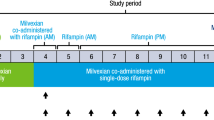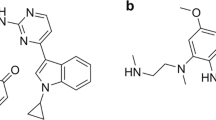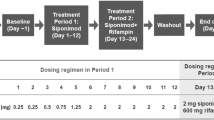Abstract
Objective
To investigate if rifampicin is both an inducer and an inhibitor of repaglinide metabolism, it was determined whether the timing of rifampicin co-administration influences the pharmacokinetics of repaglinide.
Methods
Male volunteers (n=12) participated in a randomised, two-period, crossover trial evaluating the effect of multiple doses of 600 mg rifampicin once daily for 7 days on repaglinide metabolism. Subjects were, after baseline measurements of repaglinide pharmacokinetics, randomised to receive, on either day 7 or day 8 of the rifampicin administration period, a single dose of 4 mg repaglinide and vice versa in the following period.
Results
When repaglinide was given, together with the last rifampicin dose, on day 7, an almost 50% reduction of the median repaglinide area under the plasma concentration–time curve (AUC) was observed. Neither the peak plasma concentration (Cmax), time to reach Cmax (tmax) nor terminal half-life (t1/2) was statistically significantly affected. When repaglinide was given on day 8, 24 h after the last rifampicin dose, an almost 80% reduction of the median repaglinide AUC was observed. The median Cmax was now statistically significantly reduced from 35 ng/ml to 7.5 ng/ml. Neither tmax nor t1/2 was significantly affected.
Conclusion
When rifampicin and repaglinide are administered concomitantly, rifampicin seems to act as both an inducer and an inhibitor of the metabolism of repaglinide. After discontinuing rifampicin administration, while the inductive effect on CYP3A4 and probably also CYP2C8 is still present, an even more marked reduction in the plasma concentration of repaglinide was observed. Our results suggest that concomitant administration of rifampicin and repaglinide may cause a clinically relevant decrease in the glucose-lowering effect of repaglinide, in particular when rifampicin treatment is discontinued or if the drugs are not administered simultaneously or within a few hours of each other.



Similar content being viewed by others
References
Gromada J, Dissing S, Kofod H, Frokjaer-Jensen J (1995) Effects of the hypoglycaemic drugs repaglinide and glibenclamide on ATP-sensitive potassium-channels and cytosolic calcium levels in beta TC3 cells and rat pancreatic beta cells. Diabetologia 38:1025–1032
Nattrass M, Lauritzen T (2000) Review of prandial glucose regulation with repaglinide: a solution to the problem of hypoglycaemia in the treatment of type 2 diabetes? Int J Obes 24:S21–S31
van Heiningen PN, Hatorp V, Kramer Nielsen K, Hansen KT, van Lier JJ, van De Merbel NC, Oosterhuis B, Jonkman JHG (1999) Absorption, metabolism and excretion of a single oral dose of14C-repaglinide during repaglinide multiple dosing. Eur J Clin Pharmacol 55:521–525
Bidstrup TB, Bjørnsdottir I, Sidelmann UG, Thomsen MS, Hansen KT (2003) CYP2C8 and CYP3A4 are the principal enzymes involved in the human in vitro biotransformation of the insulin secretagogue repaglinide. Br J Clin Pharmacol 56:305–314
Hatorp V, Hansen KT, Thomsen MK (2003) Influence of drugs interacting with CYP3A4 on the pharmacokinetics, pharmacodynamics, and safety of the prandial glucose regulator repaglinide. J Clin Pharmacol 43:649–660
Niemi M, Backman JT, Neuvonen M, Neuvonen PJ, Kivistö KT (2000) Rifampin decreases the plasma concentrations and effects of repaglinide. Clin Pharmacol Ther 68:495–500
Damkier P, Brosen K (2000) Quinidine as a probe for CYP3A4 activity: intrasubject variability and lack of correlation with probe-based assays for CYP1A2, CYP2C9, CYP2C19, and CYP2D6. Clin Pharmacol Ther 68:199–209
Tran JQ, Kovacs SJ, McIntosh TS, Davis HM, Martin DE (1999) Morning spot and 24-hour urinary 6β-hydroxycortisol to cortisol ratios: intraindividual variability and correlation under basal conditions and conditions of CYP 3A4 induction. J Clin Pharmacol 39:487–494
Ged C, Rouillon JM, Pichard L, Combalbert J, Bressot N, Bories P, Michel H, Beaune P, Maurel P (1989) The increase in urinary excretion of 6-beta hydroxycortisol as a marker of human hepatic cytochrome P 450IIIa induction. Br J Clin Pharmacol 28:373–387
Nielsen F, Nielsen KK, Brøsen K (1994) Determination of quinidine, dihydroquinidine, (3S)-3-hydroxyquinidine and quinidine N-oxide in plasma and urine by high-performance liquid chromatography. J Chromatogr B 660:103–110
Lykkesfeldt J, Loft S, Poulsen HE (1994) Simultaneous determination of urinary free cortisol and 6 beta-hydroxycortisol by high-performance liquid chromatography to measure human CYP3A activity. J Chromatogr B 660:23–29
Gerbal-Chaloin S, Pascussi JM, Pichard-Garcia L, Daujat M, Waechter F, Fabre JM, Carrere N, Maurel P (2001) Induction of CYP2C genes in human hepatocytes in primary culture. Drug Metab Dispos 29:242–251
Rae JM, Jhonson MD, Lippman ME, Flockhart DA (2001) Rifampin is a selective, pleiotropic inducer of drug metabolism genes in human hepatocytes: studies with cDNA and oligonucleotide expression arrays. J Pharmacol Exp Ther 299:849–857
Raucy JL, Mueller L, Duan K, Allen SW, Strom S, Lasker JM (2002) Expression and induction of CYP2C P 450 enzymes in primary cultures of human hepatocytes. J Pharmacol Exp Ther 302:475–482
Niemi M, Backman JT, Neuvonen M, Neuvonen PJ (2003) Effects of gemfibrozil, itraconazole, and their combination on the pharmacokinetics and pharmacodynamics of repaglinide: potentially hazardous interaction between gemfibrozil and repaglinide. Diabetologia 46:347–351
Wang J, Neuvonen M, Wen X, Backman JT, Neuvonen PJ (2002) Gemfibrozil inhibits CYP2C8-mediated cerivastatin metabolism in human liver microsomes. Drug Metab Dispos 30:1352–1356
Wen X, Wang J, Backman JT, Kivistö KT, Neuvonen PJ (2001) Gemfibrozil is a potent inhibitor of human cytochrome P 4502C9. Drug Metab Dispos 29:1359–1361
Nielsen TL, Rasmussen BB, Flinois J, Beaune P, Brøsen K (1999) In vitro metabolism of quinidine: the (3S)-3-hydroxylation of quinidine is a specific marker reaction for cytochrome P 4503A4 activity in human liver microsomes. J Pharmacol Exp Ther 289:31–37
Niemi M, Backman JT, Fromm MF, Neuvonen PJ, Kivistö KT (2003) Pharmacokinetic interactions with rifampicin—clinical relevance. Clin Pharmacokinet 42:819–850
Kolars JC, Schmiedlin-Ren P, Schuetz JD, Fang C, Watkins PB (1992) Identification of rifampin-inducible P 450IIIA4 (CYP3A4) in human small bowel enterocytes. J Clin Invest 90:1871–1878
Glaeser H, Drescher S, van der Kuip H, Behrens C, Geick A, Burk O, Dent J, Somogyi A, von Richter O, Griese E, Eichelbaum M, Fromm MF (2002) Shed human enterocytes as a tool for the study of expression and function of intestinal drug-metabolizing enzymes and transporters. Clin Pharmacol Ther 71:131–140
Klose TS, Blaisdell J, Goldstein JA (1999) Gene structure of CYP2C8 and extrahepatic distribution of the human CYP2Cs. J Biochem Mol Toxicol 13:289–295
Schuetz EG, Beck WT, Schuetz JD (1996) Modulators and substrates of P-glycoprotein a cytochrome P 4503A coordinately up-regulates these proteins in human colon carcinoma cells. Mol Pharmacol 49:311–318
Fardel O, Lecureur V, Loyer P, Guillouzo A (1995) Rifampicin enhances anti-cancer drug accumulation and activity in multidrug-resistant cells. Biochem Pharmacol 49:1255–1260
Zong J, Pollack GM (2003) Modulation of P-glycoprotein transport activity in the mouse blood–brain barrier by rifampin. J Pharmacol Exp Ther 306:556–562
Niemi M, Leathart JB, Neuvonen M, Backman JT, Daly AK, Neuvonen PJ (2003) Polymorphism in CYP2C8 is associated with reduced plasma concentrations of repaglinide. Clin Pharmacol Ther 74:380–387
Acknowledgements
Novo Nordisk A/S, Denmark, financed this study. This experiment complies with the current law of the country in which it was performed (Denmark).
Author information
Authors and Affiliations
Corresponding author
Additional information
The work was carried out at Odense University Hospital and Clinical Pharmacology, University of Southern Denmark, Winsløwparken 192, 5000 Odense C, Denmark
Rights and permissions
About this article
Cite this article
Bidstrup, T.B., Stilling, N., Damkier, P. et al. Rifampicin seems to act as both an inducer and an inhibitor of the metabolism of repaglinide. Eur J Clin Pharmacol 60, 109–114 (2004). https://doi.org/10.1007/s00228-004-0746-z
Received:
Accepted:
Published:
Issue Date:
DOI: https://doi.org/10.1007/s00228-004-0746-z




